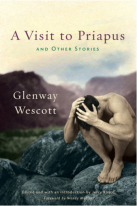 Wescott, Glenway. A Visit to Priapus and Other Stories. Ed. by Jerry Rosco. The University of Wisconsin Press. 2013. $26.95. 208p. HC. 978-0-299-29690-2.
Wescott, Glenway. A Visit to Priapus and Other Stories. Ed. by Jerry Rosco. The University of Wisconsin Press. 2013. $26.95. 208p. HC. 978-0-299-29690-2.
A prominent gay author from Wisconsin, Glenway Wescott spent most of his adult life in Europe, New York City, and New Jersey. He is often compared to E.M. Forster, whose landmark gay novel Maurice was not published until well after his death. The 10 short stories and two essays in this posthumous collection date from 1923 to 1971, some of them published for the first time in this country.
Only the longest of these stories, “A Visit to Priapus,” has discernible gay content. The story’s focus is primarily a psychological analysis of the bookish narrator’s feelings and his “trick.” In a day and night spent with a Maine young man famous for his outsized penis, the narrator finds the sex unsatisfactory because the young man doesn’t know what to do with his penis.
Most of the other stories and essays also focus on psychological analysis. “Adolescence,” first published in the author’s collection Goodbye, Wisconsin (1928), finds the narrator’s friends making him uncomfortable by urging him to dress in women’s clothing at a costume birthday party. “Mr. Auerbach in Paris” is about the narrator’s apprenticeship to an elderly German Jew, now going blind and living in the United States. When they journey to Europe so that Auerback can purchase art works, the German extols the virtues of his native country as the most advanced in the world. “The Babe’s Bed” describes ne’er-do-well young parents forced to move back to the wife’s parents’ home and frustrated because they cannot agree on proper child-rearing practice.
Two other stories provide a detailed description of large stallions impregnating mares and a man serving in the French Army and demoralized by the possible disaster of a looming war with Germany. One story set in New York City shows the narrator’s love for the city whereas another concentrates on a man threatening to jump off the 17th floor of a large hotel. Set on a cruise ship in the Mediterranean, “The Odor of Rosemary” refers to the plant’s scent from the south Spanish coast as the narrator talks with a young man who asks if Spain is an island.
One of two essays, “The Valley Submerged,” takes place in New Jersey where the Spruce Run Reservoir submerges the narrator’s home. The other, “A Call on Colette and Goudeket,” is a detailed record of the narrator’s visit with these notable literary figures in Paris. The final story, the experimental “Sacre de Printemps,” covers the relationship of two young Americans at Oxford in England.
In the Foreword, Wendy Moffat writes that Visit is “a meditation on desire and art, a rueful, comic, brutally honest consideration of sex and its human limitations.” Elegant, introspective, and enigmatic, the stories have an important place in collections of great American authors but not necessarily in those that concentrate on titles with significant literary content.
James Doig Anderson, Professor Emeritus
Library and Information Science, Rutgers University